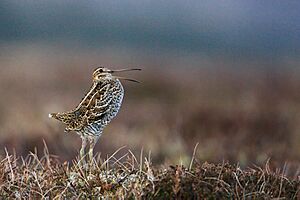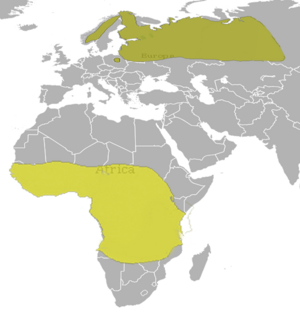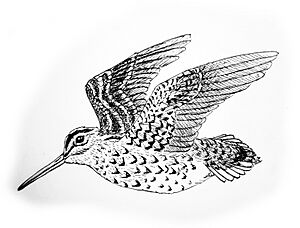Great snipe facts for kids
Quick facts for kids Great snipe |
|
|---|---|
 |
|
| Conservation status | |
| Scientific classification | |
 |
|
| Range of G. media Breeding range Non-breeding range | |
| Synonyms | |
|
Capella media (Latham, 1787) |
The great snipe (Gallinago media) is a medium-sized bird that loves wet places. It's a type of wader, which means it often walks in shallow water or mud to find food. These birds breed in marshy areas and wet meadows with short plants in north-eastern Europe, including parts of Russia. When winter comes, great snipes fly all the way to Africa because they are migratory birds. Sadly, the number of great snipes breeding in Europe is going down quickly.
Contents
About the Great Snipe's Name
The great snipe was first described by an English scientist named John Latham in 1787. He gave it the scientific name Scolopax media.
Today, its scientific name is Gallinago media. The word Gallinago comes from Latin and means something like "hen-like" or "resembling a hen". The word media is also Latin and means "intermediate" or "middle". This is because the great snipe is a middle size between the larger woodcock and the smaller common snipe.
What Does a Great Snipe Look Like?
Great snipes are about 26 to 30 centimeters (10 to 12 inches) long. Their wings can spread out to 42 to 50 centimeters (16 to 20 inches). They are a bit bigger and much chunkier than the common snipe. They also have a shorter beak.
Their bodies are mottled brown on top, which means they have patches of different brown shades. Their undersides have stripes. They also have a dark stripe that goes through their eye. When they fly, you can see their wide wings and a pale bar on their wings.
The great snipe's call is a soft "yeah." When groups of males are trying to attract mates, their calls can be heard from far away. They sound like a mix of firecrackers, wind-up toys, and xylophones.
Great Snipe Behavior and Lifestyle
Great snipes are amazing flyers! They can fly very fast without stopping for long distances. They can reach speeds of up to 97 kilometers per hour (60 mph). Scientists have found that they don't seem to need much wind to help them. Some great snipes have flown non-stop for 84 hours! That's over 6,760 kilometers (4,200 miles) at heights up to 8,700 meters (28,500 feet).
Their wings are not super aerodynamic, meaning they aren't shaped perfectly for flight. They don't have pointed tips like some fast-flying birds. Even though they have chances to stop and eat, they usually don't. Instead, they rely on the fat they have stored in their bodies for energy.
Reproduction and Nesting
During the breeding season, male great snipes gather at a special area called a lek. This is like a display arena where they try to attract females. They stand tall, puff out their chests, and fan out their tails. They might even jump into the air. While displaying, they make many different sounds, like rattles, clicks, buzzes, and whistles.
Female great snipes lay three to four eggs. They build their nests on the ground, making sure they are well hidden in the plants.
What Do Great Snipes Eat?
These birds look for food in soft mud. They either poke their long beaks into the mud or pick up food they see. They mostly eat insects and earthworms. Sometimes, they also eat small bits of plants.
Great snipes are hard to spot because their brown feathers help them blend in with their habitat. If you scare one out of its hiding spot, it will fly straight for a long distance before landing back in the plants.
Amazing Migrations
Great snipes make incredible journeys during their seasonal migrations. They fly non-stop between Sweden and sub-Saharan Africa. These flights can be 4,000 to 7,000 kilometers (2,500 to 4,300 miles) long and last for 60 to 90 hours!
During these long flights, great snipes often change their altitude. Around dawn and dusk, they fly lower, about 2,000 meters (6,500 feet) above sea level at night. During the day, they fly higher, around 4,000 meters (13,000 feet). Many birds regularly fly at 6,000 meters (19,700 feet). One bird even reached an amazing 8,700 meters (28,500 feet)! This might be the highest altitude ever recorded for a migrating bird.
Great Snipe History and Fossils
Scientists have found fossils of the great snipe in North Carolina, in the United States. These fossils are very old, dating back about 4.465 million years. This discovery suggests that at some point in history, the great snipe must have crossed the Atlantic Ocean.
Protecting the Great Snipe
In 2012, experts estimated there were between 15,000 and 40,000 great snipes in Scandinavia. There were many more, between 450,000 and 1,000,000, in western Siberia and northeastern Europe.
However, the number of great snipes is going down. This is mainly because they are losing their natural homes, called habitat loss. Hunting in eastern Europe and in their winter homes in Africa also affects their numbers. Because of this decline, the International Union for Conservation of Nature has classified the great snipe as "Near Threatened." This means they could become endangered if their numbers keep dropping.
The great snipe is also protected by an agreement called the Agreement on the Conservation of African-Eurasian Migratory Waterbirds (AEWA). This agreement helps protect birds that migrate across Africa and Eurasia.





